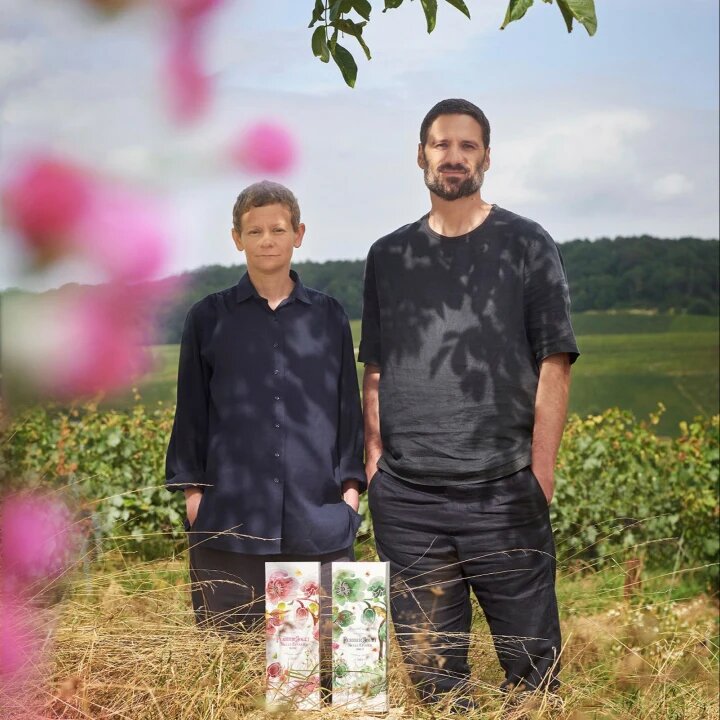The Monday we speak, Katharina Mischer and Thomas Traxler are still in their studio in Vienna but very much hoping that they will soon be on a flight to Miami. The journey out of a city in a new lockdown is important: both are required to install a piece of work at Design Miami.
Called “Embodied Nature”, and commissioned by the champagne house of Perrier-Jouët, it is a project in which the pair demonstrate how deeply interlinked all lifeforms are, from the barely visible bacteria to fungi, insects, plants and human beings. Through a combination of laser-cut metal models, a real-time animation shown on a screen and a soundscape delivered through six speakers, they aim to evoke the deep complexity of the Earth’s ecological system and place man as an equal, not exalted, player within it.
The irony of dedicating much of their work to a message of biodiversity while having to jump on a plane is not lost on the couple. “We are so aware that, as privileged people living in a privileged first-world country, our carbon footprint is way bigger than most,” says Mischer over Zoom. “But we are as cautious as we can be. The first time we install a piece, we need to be there. But after that, it can travel without us. We have started to make detailed films about how to set up our work and it’s meant, for example, that we didn’t have to go to Tokyo or Shanghai this year, where our work was to be shown. That’s a start.”
Mischer and Traxler, who have been a couple for 17 years and have a three-and-a-half-year-old son, attended design school together, first in a small town in Austria, then at the Design Academy Eindhoven in the Netherlands during its most gilded period.
“We picked that school on purpose,” says Mischer, with Traxler at her side. “We’d already discovered that we wanted to focus on developing important questions rather than on the answers, and we knew we could pursue that at Eindhoven.” “We didn’t want to be involved in mass-production or making more and more objects,”continues Traxler. “I think you could say that we’ve ended up as communication designers who work in 3D, communicating messages through installations and sometimes objects.”
Testament to the clarity of their thinking is the longevity of their projects. One — “the idea of a tree” — began in 2008, at the time of their graduation when they were both 25. For this, they developed a machine that ran off sunlight to wind cotton thread around a form until it created an autonomous object — lampshades, benches, sideboards and seats. The resulting depth of the cotton layer and of its colour is directly related to the amount of sunshine available during the process.
“At the time, we were questioning the laws that govern standard production and looking for a natural rhythm of production instead, one that came from nature itself,” says Mischer. “We can still use the machine now, but it needs updating with ecological materials, natural fibres and pigments.” He mentions progress that has been made in this regard: Crafting Plastics, a Slovakian company creating sustainable plastics, and Mogu, an Italian outfit making acoustic panels from fungal mycelium and textile residue. “Our projects are so systematic they have a long and adaptable life,” says Traxler.
When they were children, they tell me, the Green movement was making headway in Austria. “We were educated about recycling and nature and conservation. The building of nuclear power plants was stopped. A big damn proposed for the Danube was suppressed and the area became an outstanding nature reserve,” says Traxler. Mischer now describes the country as lagging behind again. Its biodiversity is suffering, and another project, which also goes back to 2008, details this. In “realLimited”, the pair have produced delicate metal versions of the remaining species of fungi, ferns and moths that are left in their country. “We try and connect it to the real numbers,” says Mischer. “Ten per cent of the profit from sales goes back to the Worldwide Fund for Nature Austria.”
While the pair struggled in their early working years, now even luxury companies are keen to embrace their work as interest in biodiversity has grown. Hermès in Japan invited them to create window displays a few years ago; a version of their “Curiosity Cloud” — an arrangement of myriad suspended glass bulbs, containing artificial endangered species that come to life when approached by a person — is going to a snazzy development of restaurants in south-east Asia, having first been commissioned by Perrier-Jouët in 2015.
“But it’s important to say how much we’ve changed our perspective over time,” says Mischer, “to become more concerned about the entanglement of the natural world and the importance of its interdependence. That is why all the species we are showing in Miami, in models and illustrations — whether it’s a microbe or a potato or a squirrel or an algae or a tree — are all around the same size.” The show includes data from regions including Germany, the Barrier Reef and an area in South America “where potatoes are a central species. Where they are key to filtering the air,” says Mischer.
Perrier-Jouët’s interest is apparently more than skin deep. The house is working with scientists to create a more responsible form of viniculture. In the luxury sector now, there are enough consumers who look for a product’s ethical value. “Industry and consumers attitudes are evolving faster than the political machine,” says Mischer. “We’re literally waiting for legislation to be delivered around practices that are already taking place. Consumers are invested in the intangible qualities of objects — in labour, in materials, in environmental impact.” Mischer’Traxler are here to tell us we’re right.


